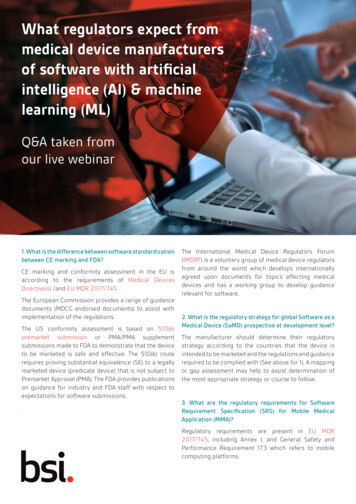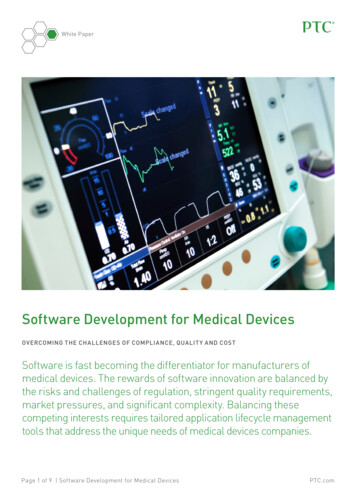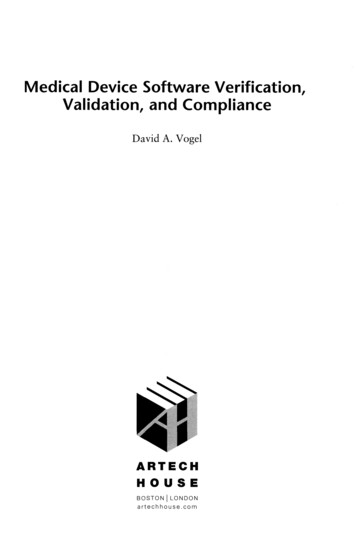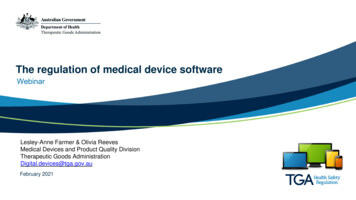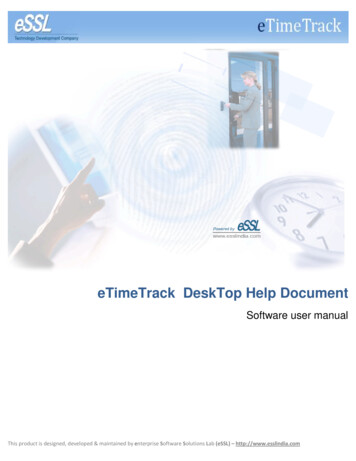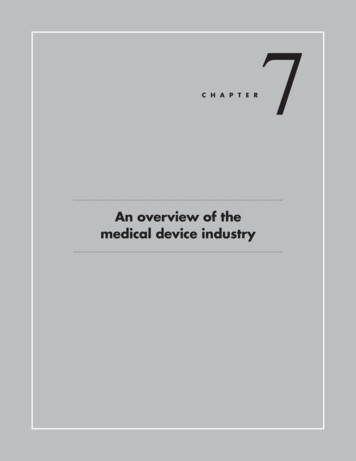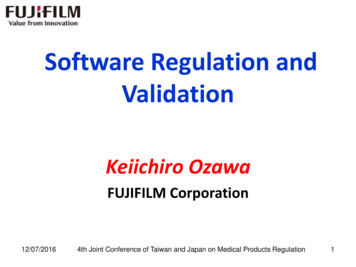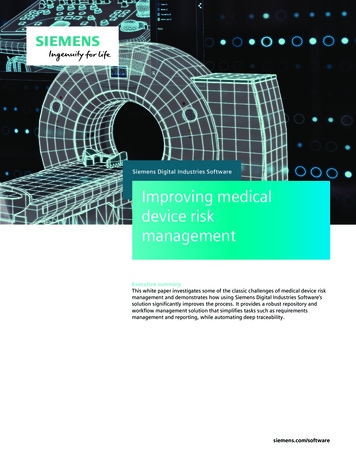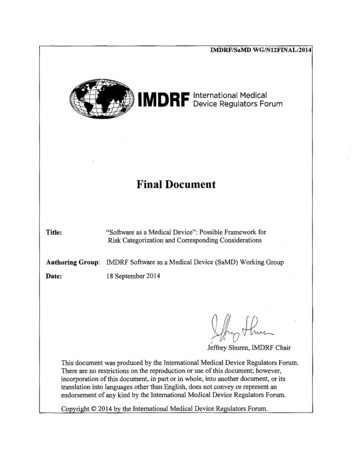
Transcription
IMDRF/SaMD WG/N12FINAL:2014IMDRFInternational MedicalDevice Regulators ForumFinal DocumentTitle:"Software as a Medical Device": Possible Framework forRisk Categorization and Corresponding ConsiderationsAuthoring Group:IMDRF Software as a Medical Device (SaMD) Working GroupDate:18 September 2014YfhJ!LJeffrey Shuren, IMDRF ChairThis document was produced by the International Medical Device Regulators Forum.There are no restrictions on the reproduction or use of this document; however,incorporation of this document, in part or in whole, into another document, or itstranslation into languages other than English, does not convey or represent anendorsement of any kind by the International Medical Device Regulators Forum.Co yright 2014 by the International Medical Device Re ulators Forum.
IMDRF/SaMD WG/N12FINAL:2014Table of Contents1.0Introduction . 42.0Scope. 53.0Definitions . 73.13.23.33.4SOFTWARE AS A MEDICAL DEVICE . 7INTENDED USE / INTENDED PURPOSE. 7MEDICAL PURPOSE. 7SAMD CHANGES. 94.0SaMD Background and Aspects Influencing Patient Safety. 95.0Factors Important for SaMD Characterization . 105.15.2SIGNIFICANCE OF INFORMATION PROVIDED BY SAMD TO HEALTHCARE DECISION . 10HEALTHCARE SITUATION OR CONDITION . 116.0SaMD Definition Statement . 127.0SaMD Categorization . 0CATEGORIZATION PRINCIPLES . 13SAMD CATEGORIES . 14CRITERIA FOR DETERMINING SAMD CATEGORY . 14EXAMPLES OF SAMD: . 15General Considerations for SaMD . 20DESIGN AND DEVELOPMENT . 20CHANGES . 22Specific Considerations for SaMD . 23SOCIO-TECHNICAL ENVIRONMENT CONSIDERATIONS . 23TECHNOLOGY AND SYSTEM ENVIRONMENT CONSIDERATIONS. 25INFORMATION SECURITY WITH RESPECT TO SAFETY CONSIDERATIONS . 26Appendix . 27CLARIFYING SAMD DEFINITION . 27ANALYSIS OF SAMD FRAMEWORK WITH EXISTING CLASSIFICATIONS . 29References . 3018 September 2014Page 2 of 30
IMDRF/SaMD WG/N12FINAL:2014PrefaceThe document herein was produced by the International Medical Device Regulators Forum(IMDRF), a voluntary group of global medical device regulators from around the world. Thedocument has been subject to consultation throughout its development.There are no restrictions on the reproduction, distribution or use of this document; however,incorporation of this document, in part or in whole, into any other document, or its translationinto languages other than English, does not convey or represent an endorsement of any kind bythe International Medical Device Regulators Forum.18 September 2014Page 3 of 30
IMDRF/SaMD WG/N12FINAL:20141.0 IntroductionSoftware is playing an increasingly important and critical role in healthcare with many clinicaland administrative purposes.Software used in healthcare operates in a complex socio-technical environment—consisting ofsoftware, hardware, networks, and people—and frequently forms part of larger systems that mustoperate in a unified manner. This software frequently depends on other commercial off-theshelf (COTS) software and on other systems and data repositories for source data.A subset of software used in healthcare meets the definition of a medical device; globally,regulatory authorities regulate such software accordingly.Existing regulations for medical device software are largely focused on medical device softwarethat is embedded in dedicated hardware medical devices and are focused around physical harm,transmission of energy and/or substances to or from the body, the degree of invasiveness to thebody, closeness to sensitive organs, duration of use, diseases, processes and public health risk,competence of user and effect on population due to communicable diseases, etc.Today, medical device software is often able to attain its intended medical purpose independentof hardware medical devices. It is increasingly being deployed on general-purpose hardware anddelivered, in diverse care settings, on a multitude of technology platforms (e.g., personalcomputers, smart phones, and in the cloud) that are easily accessible. It is also beingincreasingly interconnected to other systems and datasets (e.g., via networks and over theInternet).The complexity of medical device software, together with the increasing connectedness ofsystems, results in emergent behaviors not usually seen in hardware medical devices.This introduces new and unique challenges. For example: Medical device software might behave differently when deployed to different hardwareplatforms.Often an update made available by the manufacturer is left to the user of the medicaldevice software to install.Due to its non-physical nature (key differentiation), medical device software may beduplicated in numerous copies and widely spread, often outside the control of themanufacturer.Furthermore, there are lifecycle aspects of medical device software that pose additionalchallenges. For instance, software manufacturers often: Have rapid development cycles,Introduce frequent changes to their software, andDeliver updates by mass and rapid distribution.18 September 2014Page 4 of 30
IMDRF/SaMD WG/N12FINAL:2014This document is focused on a selected subset of medical device software. This software iscalled Software as a Medical Device (SaMD) and is defined in IMDRF SaMD WG N10 /Software as a Medical Device: Key Definitions.Definition: Software as a Medical Device 1SaMD is defined as software intended to be used for one or more medicalpurposes that perform these purposes without being part of a hardwaremedical device.The objective of this document is to introduce a foundational approach, harmonized vocabularyand general and specific considerations for manufacturers, regulators, and users alike to addressthe unique challenges associated with the use of SaMD.The approach developed in this document is intended only to establish a common understandingfor SaMD and can be used as reference. This document is not intended to replace or modifyexisting regulatory classification schemes or requirements. Further efforts are required prior tothe use of this foundational approach for possible regulatory purposes.2.0 ScopePurpose of the documentThe purpose of the document is to introduce a foundational approach, harmonized vocabularyand general and specific considerations, for manufacturers, regulators, and users alike to addressthe unique challenges associated with the use of SaMD by;1 Establishing common vocabulary and an approach for categorizing SaMD; Identifying specific information for describing SaMD in terms of the significance of theinformation provided by the SaMD to the healthcare decision, healthcare situation orcondition, and core functionality; Providing criteria to categorize SaMD based on the combination of the significance of theinformation provided by the SaMD to the healthcare decision and the healthcare situationor condition associated with SaMD; andSee Section 3.0 for full definition including notes.18 September 2014Page 5 of 30
IMDRF/SaMD WG/N12FINAL:2014 Identifying appropriate considerations, during the lifecycle process (requirements, design,development, testing, maintenance and use) of SaMD.Field of application The categorization system in this document applies to SaMD defined in the relateddocument, IMDRF SaMD WG N10 / Software as a Medical Device: Key Definitions anddoes not address other types of software. Software intended as an accessory to a medical device (i.e., software that does not initself have a medical purpose) is not in the scope of this document. This document focuses on the SaMD irrespective of software technology and/or theplatform (e.g., mobile app, cloud, server). This document does not address software that drives or controls a hardware medicaldevice.Relationship to other regulatory classification and standards 22 This document is not intended to replace or create new risk management practices ratherit uses risk management principles (e.g., principles in international standards) to identifygeneric risks for SaMD. The categorization framework in this document is not a regulatory classification, norimplies a convergence of classifications rules. However, it does set a path towardscommon vocabulary and approach. Additional work is required to align existingclassification rules with this framework. The categorization framework is not meant to replace or conflict with the content and/ordevelopment of technical or process standards related to software risk managementactivities.Additional details can be found in Appendix 0.18 September 2014Page 6 of 30
IMDRF/SaMD WG/N12FINAL:20143.0 Definitions3.1Software as a Medical DeviceThe term “Software as a Medical Device” (SaMD) is defined as software intended to be used forone or more medical purposes that perform these purposes without being part of a hardwaremedical device.NOTES: 3.2SaMD is a medical device and includes in-vitro diagnostic (IVD) medical device.SaMD is capable of running on general purpose (non-medical purpose) computingplatforms. 3“without being part of” means software not necessary for a hardware medical deviceto achieve its intended medical purpose.Software does not meet the definition of SaMD if its intended purpose is to drive ahardware medical device.SaMD may be used in combination (e.g., as a module) with other products includingmedical devices.SaMD may be interfaced with other medical devices, including hardware medicaldevices and other SaMD software, as well as general purpose software.Mobile apps that meet the definition above are considered SaMD.Intended use / Intended PurposeFor SaMD intended use, the definition in GHTF/SG1/N70:2011 “Label and Instructions for Usefor Medical Devices” applies:The term “intended use / intended purpose” is the objective intent of the manufacturer regardingthe use of a product, process or service as reflected in the specifications, instructions andinformation provided by the manufacturer.3.3Medical PurposeThe following two terms as defined in GHTF/SG1/N71:2012 “Definition of the Terms ‘MedicalDevice’ and ‘In Vitro Diagnostic (IVD) Medical Device” (italicized below) identify medicalpurpose applicable to SaMD:3.3.1 Medical Device‘Medical device’ means any instrument, apparatus, implement, machine, appliance, implant,reagent for in vitro use, software, material or other similar or related article, intended by the3“Computing platforms” include hardware and software resources (e.g. operating system, processing hardware,storage, software libraries, displays, input devices, programming languages etc.).“Operating systems” that SaMD require may be run on a server, a workstation, a mobile platform, or other generalpurpose hardware platform.18 September 2014Page 7 of 30
IMDRF/SaMD WG/N12FINAL:2014manufacturer to be used, alone or in combination, for human beings, for one or more of thespecific medical purpose(s) of: diagnosis, prevention, monitoring, treatment or alleviation of disease,diagnosis, monitoring, treatment, alleviation of or compensation for an injury,investigation, replacement, modification, or support of the anatomy or of a physiologicalprocess,supporting or sustaining life,control of conception,disinfection of medical devices,providing information by means of in vitro examination of specimens derived from thehuman body;and does not achieve its primary intended action by pharmacological, immunological ormetabolic means, in or on the human body, but which may be assisted in its intended function bysuch means.Note: Products which may be considered to be medical devices in some jurisdictions but not inothers include: disinfection substances, aids for persons with disabilities, devices incorporating animal and/or human tissues, devices for in vitro fertilization or assisted reproduction technologies.3.3.2 In Vitro Diagnostic (IVD) Medical Device‘In Vitro Diagnostic (IVD) medical device’ means a medical device, whether used alone or incombination, intended by the manufacturer for the in-vitro examination of specimens derivedfrom the human body solely or principally to provide information for diagnostic, monitoring orcompatibility purposes.Note 1: IVD medical devices include reagents, calibrators, control materials, specimenreceptacles, software, and related instruments or apparatus or other articles and are used, forexample, for the following test purposes: diagnosis, aid to diagnosis, screening, monitoring,predisposition, prognosis, prediction, determination of physiological status.Note2: In some jurisdictions, certain IVD medical devices may be covered by other regulations.3.3.3Additional considerations for SaMDSaMD may also: Provide means and suggestions for mitigation of a disease. Provide information for determining compatibility, detecting, diagnosing,monitoring or treating physiological conditions, states of health, illnesses orcongenital deformities. Aid to diagnosis, screening, monitoring, determination of predisposition;prognosis, prediction, determination of physiological status.18 September 2014Page 8 of 30
IMDRF/SaMD WG/N12FINAL:20143.4SaMD ChangesSaMD changes refer to any modifications made throughout the lifecycle of the SaMD includingthe maintenance phase.Software maintenance 4 can include adaptive (e.g. keeps pace with the changing environment),perfective (e.g. recoding to improve software performance), corrective (e.g., corrects discoveredproblems), or preventive (e.g., corrects latent faults in the software product before they becomeoperational faults).Examples of SaMD changes include, but are not limited to, defect fixes; aesthetic, performanceor usability enhancements; and security patches.4.0 SaMD Background and Aspects Influencing Patient SafetyThere are many aspects in an ever-increasing complex clinical use environment that can raise orlower the potential to create hazardous situations to patients. Some examples of these aspectsinclude: 4The type of disease or conditionFragility of the patient with respect to the disease or conditionProgression of the disease or the stage of the disease/conditionUsability of the applicationDesigned towards a specific user typeLevel of dependence or reliance by the user upon the output informationAbility of the user to detect an erroneous output informationTransparency of the inputs, outputs and methods to the userLevel of clinical evidence available and the confidence on the evidenceThe type of output information and the level of influence on the clinical interventionComplexity of the clinical model used to derive the output informationKnown specificity of the output informationMaturity of clinical basis of the software and confidence in the outputBenefit of the output information vs. baselineISO/IEC 14764:2006 Software Engineering — Software Life Cycle Processes — Maintenance adaptive maintenance: the modification of a software product, performed after delivery, to keep a softwareproduct usable in a changed or changing environment perfective maintenance: the modification of a software product after delivery to detect and correct latentfaults in the software product before they are manifested as failures corrective maintenance: the reactive modification of a software product performed after delivery to correctdiscovered problems preventive maintenance: the modification of a software product after delivery to detect and correct latentfaults in the software product before they become operational faults18 September 2014Page 9 of 30
IMDRF/SaMD WG/N12FINAL:2014 Technological characteristics of the platform the software are intended to operate onMethod of distribution of the softwareAlthough many of these aspects may affect the importance of the output information fromSaMD, only some of these aspects can be identified by the intended use of SaMD. Generallythese aspects can be grouped into the following two major factors that provide adequatedescription of the intended use of SaMD:A. Significance of the information provided by the SaMD to the healthcare decision, andB. State of the healthcare situation or condition.When these factors are included in the manufacturer’s description of intended use, they can beused to categorize SaMD.Section 6.0 provides a structured approach for a SaMD definition statement to describe theintended use. Section 7.0 provides a method for categorizing SaMD based on the major factorsidentified in the definition statement.Other aspects that are not included in the two major factors (e.g., transparency of the inputs used,technological characteristics used by particular SaMD, etc.), although still important, do notinfluence the determination of the category of SaMD. These other aspects influence theidentification of considerations that are unique to a specific approach/method used by themanufacturer of a particular category of SaMD. For example, the type of a platform, that isconstantly changing, used in the implementation of SaMD may create considerations that areunique to that implementation. These considerations can also vary by the capabilities of themanufacturer or by the process rigor used to implement the SaMD. Appropriate considerations ofthese aspects by the manufacturers, users and other stakeholders can significantly minimizepatient safety risks.Section 8.0 provides general considerations and section 9.0 provides specific considerations thatwhen taken into account can promote safety in the creation, implementation and use of SaMD.5.0 Factors Important for SaMD Characterization5.1Significance of information provided by SaMD to healthcare decisionThe intended use of the information provided by SaMD in clinical management has differentsignificance on the action taken by the user.5.1.1 To treat or to diagnoseTreating and diagnosing infers that the information provided by the SaMD will be used to takean immediate or near term action: To treat/prevent or mitigate by connecting to other medical devices, medicinal products,general purpose actuators or other means of providing therapy to a human body18 September 2014Page 10 of 30
IMDRF/SaMD WG/N12FINAL:2014 To diagnose/screen/detect a disease or condition (i.e., using sensors, data, or otherinformation from other hardware or software devices, pertaining to a disease orcondition).5.1.2 To drive clinical managementDriving clinical management infers that the information provided by the SaMD will be used toaid in treatment, aid in diagnoses, to triage or identify early signs of a disease or condition willbe used to guide next diagnostics or next treatment interventions: To aid in treatment by providing enhanced support to safe and effective use of medicinalproducts or a medical device. To aid in diagnosis by analyzing relevant information to help predict risk of a disease orcondition or as an aid to making a definitive diagnosis. To triage or identify early signs of a disease or conditions.5.1.3 To Inform clinical managementInforming clinical management infers that the information provided by the SaMD will not triggeran immediate or near term action:5.2 To inform of options for treating, diagnosing, preventing, or mitigating a disease orcondition. To provide clinical information by aggregating relevant information (e.g., disease,condition, drugs, medical devices, population, etc.)Healthcare Situation or Condition5.2.1 Critical situation or conditionSituations or conditions where accurate and/or timely diagnosis or treatment action is vital toavoid death, long-term disability or other serious deterioration of health of an individual patientor to mitigating impact to public health. SaMD is considered to be used in a critical situation orcondition where: The type of disease or condition is:o Life-threatening state of health, including incurable states,o Requires major therapeutic interventions,o Sometimes time critical, depending on the progression of the disease or condition thatcould affect the user’s ability to reflect on the output information. Intended target population is fragile with respect to the disease or condition (e.g.,pediatrics, high risk population, etc.) Intended for specialized trained users.5.2.2 Serious situation or conditionSituations or conditions where accurate diagnosis or treatment is of vital importance to avoidunnecessary interventions (e.g., biopsy) or timely interventions are important to mitigate longterm irreversible consequences on an individual patient’s health condition or public health.SaMD is considered to be used in a serious situation or condition when:18 September 2014Page 11 of 30
IMDRF/SaMD WG/N12FINAL:2014 The type of disease or condition is:o Moderate in progression, often curable,o Does not require major therapeutic interventions,o Intervention is normally not expected to be time critical in order to avoid death, longterm disability or other serious deterioration of health, whereby providing the user anability to detect erroneous recommendations.Intended target population is NOT fragile with respect to the disease or condition.Intended for either specialized trained users or lay users.Note: SaMD intended to be used by lay users in a "serious situation or condition" asdescribed here, without the support from specialized professionals, should be consideredas SaMD used in a "critical situation or condition".5.2.3 Non-Serious situation or conditionSituations or conditions where an accurate diagnosis and treatment is important but not criticalfor interventions to mitigate long term irreversible consequences on an individual patient's healthcondition or public health. SaMD is considered to be used in a non-serious situation or conditionwhen: The type of disease or condition is:o Slow with predictable progression of disease state (may include minor chronicillnesses or states),o May not be curable; can be managed effectively,o Requires only minor therapeutic interventions, ando Interventions are normally noninvasive in nature, providing the user the ability todetect erroneous recommendations.Intended target population is individuals who may not always be patients.Intended for use by either specialized trained users or lay users.6.0 SaMD Definition StatementThe intended use of SaMD is normally reflected in various sources such as the manufacturer’sspecifications, instructions, and other information provided by the manufacturer.The purpose of the SaMD definition statement and the components identified below are toprovide an organized factual framework. Statement “A” and “B” are to help the SaMD developerdetermine the SaMD category in the categorizing framework, while statement “C” is to help themanufacturer manage changes to SaMD that may result in change of the category and to addressconsiderations specific to SaMD.The SaMD definition statement should include a clear and strong statement about intended use,including the following:A.The “significance of the information provided by the SaMD to the healthcaredecision” which identifies the intended medical purpose of the SaMD. The statement18 September 2014Page 12 of 30
IMDRF/SaMD WG/N12FINAL:2014should explain how the SaMD meets one or more of the purposes described in thedefinition of a medical device 5, e.g. supplying information for diagnosis, prevention,monitoring, treatment etc. This statement should be structured in the following termsas defined in section 5.1.o Treat or diagnoseo Drive clinical managemento Inform clinical managementB.The “state of the healthcare situation or condition” that the SaMD is intended for. Thisstatement should be structured in the following terms as defined in section 5.2.oooC.Critical situation or conditionSerious situation or conditionNon-serious situation or conditionDescription of the SaMD’s core functionality6 which identifies the criticalfeatures/functions of the SaMD that are essential to the intended significance of theinformation provided by the SaMD to the healthcare decision in the intended healthcaresituation or condition. This description should include only the critical features. (Seeapplicability of this in section 8.0, 9.0).7.0 SaMD CategorizationThis section provides an approach to categorize SaMD based on the factors identified in theSaMD definition statement.7.1Categorization PrinciplesThe following are necessary principles important in the categorization approach of SaMD. The categorization relies on an accurate and complete SaMD definition statement. The determination of the categories is the combination of the significance of the informationprovided by the SaMD to the healthcare decision and the healthcare situation or condition. The four categories (I, II, III, IV) are based on the levels of impact on the patient or publichealth where accurate information provided by the SaMD to treat or diagnose, drive orinform clinical management is vital to avoid death, long-term disability or other seriousdeterioration of health, mitigating public health. The categories are in relative significance to each other. Category IV has the highest level ofimpact, Category I the lowest.5IMDRF key definitions Final document “medical purposes” also repeated here in Section 3.3.These could include specific functionality that is critical to maintain performance and safety profile, attributesidentified by risk management process undertaken by the manufacturer of SaMD.618 September 2014Page 13 of 30
IMDRF/SaMD WG/N12FINAL:2014 When a manufacturer's SaMD definition statement states that the SaMD can be used acrossmultiple healthcare situations or conditions it is categorized at the highest category accordingto the information included in the SaMD definition statement. When a manufacturer makes changes to SaMD 7, during the lifecycle that results in thechange of the definition statement, the categorization of SaMD should be reevaluatedappropriately. The SaMD is categorized according to the information included in the changed(new) SaMD definition statement. SaMD will have its own category according to its SaMD definition statement even when aSaMD is interfaced with other SaMD, other hardware medical devices, or used as a modulein a larger system.7.2SaMD CategoriesState of Healthcaresituation or conditionCriticalSeriousNon-seriousSignificance of information provided by SaMD tohealthcare decisionTreat orDrive clinical Inform III7.3 Criteria for Determining SaMD CategoryCriteria for Category IV –i.SaMD that provides information to treat or diagnose a disease or conditions in a criticalsituation or condition is a Category IV and is considered to be of very high impact.Criteria for Category III –i.SaMD that provides information to treat or diagnose a disease or conditions in a serioussituation or condition is a Category III and is considered to be of high impact.ii.SaMD that provides information to drive clinical management of a disease or conditionsin a critical situation or condition is a Category III and is considered to be of high impact.Criteria for Category II –i.7SaMD that provides information to treat or diagnose a disease or conditions in a nonserious situation or condition is a Category II and is considered to be of medium impact.“SaMD changes” are defined in section 3.418 September 2014Page 14 of 30
IMDRF/SaMD WG/N12FINAL:2014ii.SaMD that provides information to drive clinical management of a disease or conditionsin a serious situation or condition is a Category II and is considered to be of mediumimpact.iii.SaMD that provides information to inform clinical management for a disease orconditions in a critical situation or condition is a Category II and is considered to be ofmedium impact.Criteria for Category I –i.SaMD that provides information to drive clinical management of a disease or
This software frequently depends on other commercial off-the-shelf (COTS) software and on other systems and data repositories for source data. . the definition in GHTF/SG1/N70:2011 "Label and Instructions for Use for Medical Devices" applies: The term "intended use / intended purpose" is the objective intent of the manufacturer regarding
